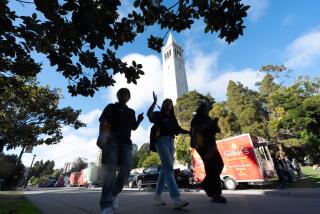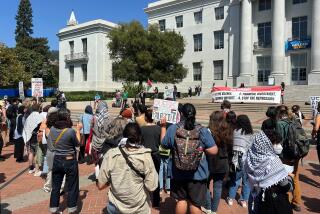CALIFORNIA ALBUM : Radical Change : Berkeley’s reputation as loose, liberal and ‘Beserkeley’ has developed a downside. Officials and merchants tired of dealing with ‘the riot of the week’ have been prompted to increase police presence on Telegraph Avenue.
- Share via
BERKELEY — Since its radical heyday in the 1960s, Berkeley has been linked in the public mind with permissiveness. But in the wake of riots by rampaging teen-agers, city officials and merchants on colorful Telegraph Avenue say it’s time to overhaul Berkeley’s reputation as a place where anything goes.
“We have this sort of ‘Berserkeley’ image . . . and there are some aspects of that image that we cherish very much,” said Marc Slavin, assistant to Berkeley Mayor Loni Hancock. “But when it gets to the extreme where we’re dealing with the riot of the week on Telegraph, we have to make it clear . . . that’s not acceptable.”
Riots are nothing new in Berkeley, beginning with the Free Speech Movement and anti-war demonstrations of the ‘60s and ‘70s. But police say the latest unrest, in which several hundred youths looted businesses and assaulted passersby on the nights of Sept. 4 and 5, were not politically motivated.
This violence was done by teen-agers, many from the nearby cities of Oakland and Richmond, who hang out on Telegraph Avenue and were looking for fun on a holiday weekend, police say. Youths armed with rocks and bottles battled police and damaged 19 businesses, causing an estimated $50,000 in damage.
Witnesses said that several of the assaults by groups of black youths on white passersby appeared to be racially motivated.
It has all left city leaders asking “Why Berkeley?”--and wondering how to prevent such violence without compromising the city’s hallmark libertarianism.
*
“Berkeley has this reputation as being liberal,” said Teri Robinson of the city manager’s office. “People feel that they can come here and do whatever they want to do and their free speech rights will be upheld.
“But we won’t tolerate this.”
Some see the recent troubles as another symptom of a general national malaise. “It reflects on the deterioration of the social fabric of the nation,” said Slavin.
Others say that Berkeley, with its reputation for unrest and its indulgent attitude, is a natural magnet for youth rebelling against authority.
Indeed, Telegraph Avenue’s sidewalks are still spray-painted with “Rosebud”--for Rosebud Denovo, the machete-wielding homeless activist killed by police in late August after she broke into the UC Berkeley chancellor’s home. Her death also set off rioting along Telegraph Avenue.
“Kids have gotten to know that this is where the excitement will be,” said Ralph Sklar, owner of the landmark Uncle Ralph’s electronic store on Telegraph. “They say, ‘Oh, a girl got shot? We know something will be going on on Telegraph this weekend.’ ”
In the most recent bout of violence, over Labor Day weekend, Sklar said, “the kids knew what they were doing when they left their homes. They brought their own weapons”--bottles to throw at police.
“There’s no other city that allows these people to go as far as they do here,” Sklar said.
City officials agree that a swift, strong response is necessary to prevent the violence from snowballing.
“Kids sit home and watch this on television and think Berkeley is the place to come for some excitement,” said Slavin.”This is an unacceptable situation. It’s not tolerable, and it’s not going to be allowed to continue.”
Yet the unrest leaves Berkeley in a quandary. On the one hand, the city has a responsibility to protect its citizens. On the other, a crackdown could draw fire from some sectors in this liberal town.
“There’s a precarious balance between over-policing and under-policing in Berkeley,” said police spokesman Lt. Tom Grant. “It’s a community that struggles with how it wants its police to operate.”
Nonetheless, Berkeley has begun to get tough. Last weekend, the city spent $17,000 to deploy about 40 police officers along Telegraph Avenue with orders to enforce the letter of the law. Hancock urged out-of-town youths to stay away.
With the heavy police presence, Telegraph remained relatively calm. Teen-agers shouted occasional epithets across the street at police. Several officers joked amicably with the youths and exchanged views on policing.
But they didn’t appear to win many converts.
“The streets belong to us!” said Cleophus Johnson, 20, of Oakland. “This is the teen hangout . . . We come here to rap and look at girls. . . . What is this, Soweto?
“This makes me not want to come to Berkeley,” Johnson said. “But that’s exactly what they want. . . . I mean, what is Telegraph if we can’t hang out here?”
*
Indeed, if ever a street was designed to attract teen-agers, it would seem to be Telegraph, with its pizza parlors, record shops, cafes and street vendors.
But last week, the City Council voted unanimously to continue the higher police presence indefinitely. The city prohibited parking in the Telegraph Avenue area after 9 p.m. on weekends, and asked businesses to voluntarily close at midnight. Council members also asked for a report on the feasibility of a curfew.
Hancock said the measures are regrettable--but it seems that Berkeley’s reputation for openness may have come back to haunt the city.
“The danger is that people will mistake liberalism and generosity for permissiveness and being a patsy,” Hancock said.
The city’s decision to increase police presence was denounced by some as being implicitly racist--designed to keep only black youths off the avenue.
“There’s riots all the time in Berkeley (without drawing a similar reaction) because usually its hippie white kids from People’s Park,” said Jolese Rodriguez, a member of Copwatch, a citizens’ rights group.
The difference, say city officials and Telegraph Avenue merchants, is that in the good old days Berkeley riots used to be political. Today’s riots are more recreational.
“Certainly places like the Bank of America and other corporations came under attack (in the ‘60s and ‘70s),” said Rebecca Rhine, president of the Telegraph Avenue Merchants’ Assn. “But you didn’t have people smashing the windows of The Gap and taking as many blue jeans as the could carry.”
More to Read
Sign up for Essential California
The most important California stories and recommendations in your inbox every morning.
You may occasionally receive promotional content from the Los Angeles Times.










